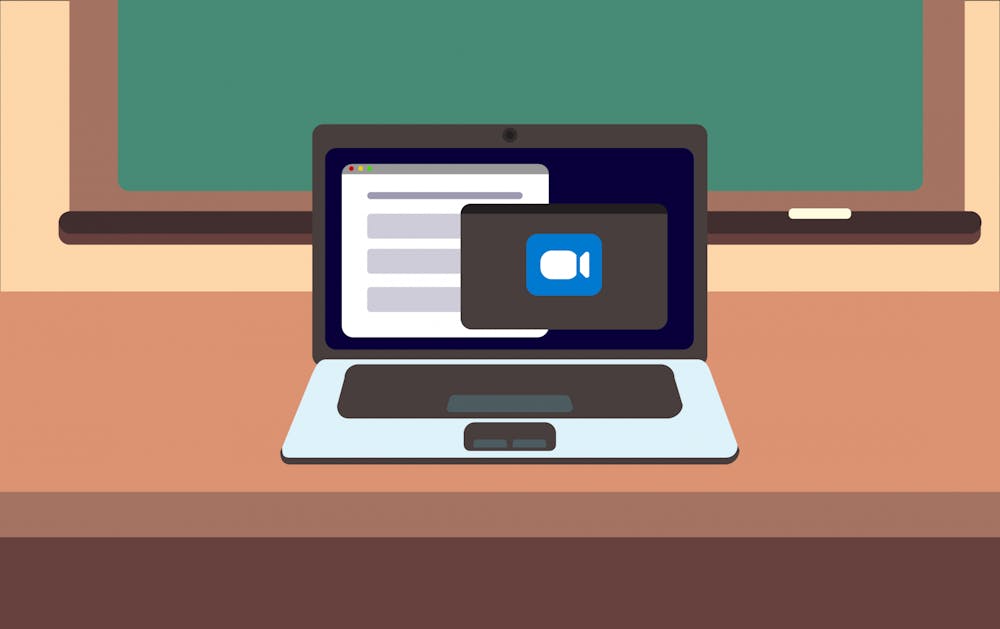Editor's Note: This article contains a tweet with offensive language.
With online classes becoming the new normal amid the coronavirus pandemic, students and teachers are forced to navigate the novel landscape of classroom participation in virtual settings.
The latest stir in the Zoom classroom is if educators should require students to keep their cameras on for instruction.
On social media, some students complain about teachers who require the use of webcams, forbid food or drinks during class and mandate no other people or animals are visible in students' rooms while in class.
Morgan Dunn, a sophomore studying sustainability, agrees these guidelines negatively impact some students.
“I don't think it would affect me at all, but I've talked to my friend, and I've been over to his house and I've seen his living situation," she said. "I just know that if he were to have guidelines it would completely suck for him.”
Dunn’s observations, like those of many students on the internet, are rooted in concerns about equity. Critics of policies requiring students to use their webcam point out some students may not feel comfortable sharing their home or living situation.
Students may not have strong enough internet connections to reliably use their webcam in every class. Some also argue that teachers should not be allowed to mandate how students manage their home environments.
Marie Winter, a French instructor in the School of International Letters and Cultures, sides with the policy cameras should remain on.
“I’m very serious about my work, and I expect the same from my students,” Winter said. “I believe everyone should have some form of rules.”
Winter detailed a set of guidelines for virtual meeting etiquette she made available to her students at the beginning of the semester. She requires students have their webcams on at all times, remain seated, dress appropriately and refrain from eating during her Zoom classes. Students receive a weekly participation grade based on their compliance with these guidelines.
In the past, she’s had students attend class from their beds in pajamas and had class disrupted by a student’s cat jumping around in the room. She’s even accidentally glimpsed a student’s partner indecently dressed in the background of their frame.
"The rules come from experience," she said. "I don’t want to see anyone’s boyfriend in their underwear."
To Winter, it’s not just a question of classroom etiquette or managing her students’ home environments. As a college instructor, she said she sees it as her duty to prepare her students for the expectations of the professional world, even when teaching remotely.
“Succeeding in a class is also about building relationships,” she said, “It’s about building something. I think I would be totally depressed if I didn’t see my students. Just looking at a photo, I don’t know who I’m talking to.”
Mark Lussier, an English professor at ASU, has a very different approach to teaching his undergraduate classes on Zoom. Instead of requiring his students to turn on their webcams, he checks in with his students verbally.
“I do not require the camera, but I do require response,” he said. “The most important feature, from my point of view, that connects us, is the language.”
He said he tries to be flexible with his students attending class via Zoom and his best teaching tends to be dynamic.
“Sometimes people, if they've got bad connections, after class they'll send an email saying 'my audio was breaking down,' and so we'll just carry on in any form or format that's available," he said. "I can't very well require that their dogs not come charging in because my dogs come charging in on occasion."
This clear discrepancy of approaches in online classroom etiquette is a microcosm of a confusing debate students and professors across the nation are engaging in.
Torrey Trust, an associate professor of education at University of Massachusetts Amherst, has developed a model for remote teaching that may begin to answer this question.
As the fall semester began, she noticed a trend in online discussion groups for teachers: Many teachers were looking for ways to force their students into turning on their webcams during class.
“This trend was alarming to me as it focused on a learning culture/environment controlled by compliance and punishment, both of which can negatively impact student learning,” she said in an email. “With my edtech (educational technology) background, I know that there are many other ways to assess learning and get feedback from students.”
Trust created a series of graphic organizers outlining some of her suggestions for how teachers and professors can assess student engagement in virtual class meetings.
Trust said she hopes her model can serve as a tool for teachers who are struggling to navigate remote learning, and help center the diverse needs of students. As a final word of advice, she reminds us that, during a global pandemic, “students need more support, guidance and flexibility than ever before.”
“Be kind. Build relationships,” she said. “Focus on people first, then content.”
Reach the reporter at lexmoulton@gmail.com and follow @lexmoul on Twitter.
Like The State Press on Facebook and follow @statepress on Twitter.




